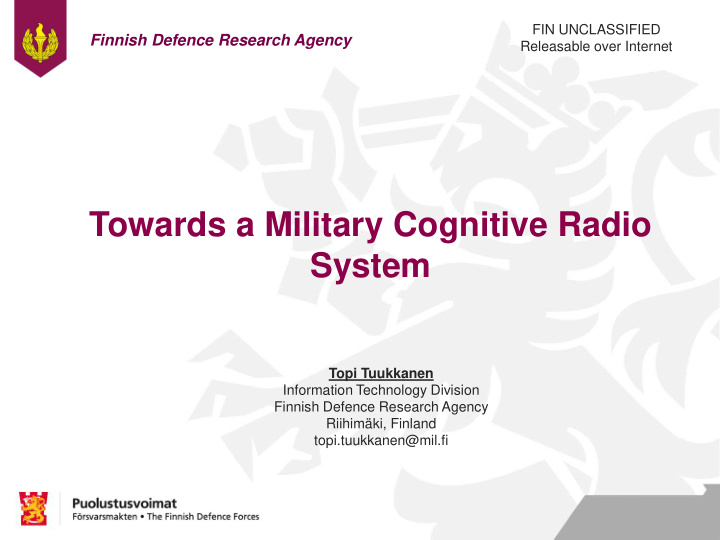



FIN UNCLASSIFIED Finnish Defence Research Agency Releasable over Internet Towards a Military Cognitive Radio System Topi Tuukkanen Information Technology Division Finnish Defence Research Agency Riihimäki, Finland topi.tuukkanen@mil.fi
Scope Scenarios Requirements CR radios with Waveform(s) Emerging CRN spectrum with x-layer waveforms Emerging CRN agility etc. capability waveforms Emerging CRN waveforms CRN Testbeds and theoretical demonstrations State-of-the-art CDR Topi Tuukkanen Research manager 22.5.2017 2 Information Technology Division
Cognitive Radio System is "A radio system employing technology that allows the system to obtain knowledge of its operational and geographical environment, established policies and its internal state; to dynamically and autonomously adjust its operational parameters and protocols according to its obtained knowledge in order to achieve predefined objectives; and to learn from the results obtained.”. Source: Definitions of Software Defined Radio (SDR) and Cognitive Radio System (CRS) ITU-R SM.2152. ITU, 2009. CDR Topi Tuukkanen Research manager 22.5.2017 3 Information Technology Division
Relative numbers of articles on Cognitive Radio and Military Cognitive Radio in IEEE Xplore database by year 14 12 10 Relative frecuency [%] 8 6 4 2 0 1999 2000 2001 2002 2003 2004 2005 2006 2007 2008 2009 2010 2011 2012 2013 2014 2015 2016 Year Military Cognitve Radio, n=474 Cognitive Radio, n=19743 CDR Topi Tuukkanen Research manager 22.5.2017 4 Information Technology Division
Cognitive Radio - expected added value WINNF-09-P-0012-V1.0.0 Quantifying the Benefits of Cognitive Radio, 2010 • Dynamic Spectrum Access • Multiple Antenna Systems • Radio Resource Management • Spectrum Markets • Single Link Adaptation • Commercial Market Characteristics • Public Safety Characteristics • Military Applications CDR Topi Tuukkanen Research manager 22.5.2017 5 Information Technology Division
CATWOE • a soft systems engineering approach proposed by P. Checkland: Soft-systems Methodology, John Wiley 1999 • Client • Actor • Transformation • Worldview • Owner • Environment CDR Topi Tuukkanen Research manager 22.5.2017 6 Information Technology Division
Dynamic Spectrum Access through DOTMLPFI • Doctrine: operational and functional benefits of improved reliability, increased availability, ease of use plus supports notions of mission command, self-synchronization, situational awareness • Organization: improved reliability and availability of communications may offer some freedom of organizational adjustment e.g. flattening hierarchy, increasing nr of sub- ordinates etc. Potentially more important than formal organizational structures is the implied operational flexibility the DSA would allow. • Training: CR generally expected to reduce training burden on end user • Materiel: first generation military CRSs expensive, deployed to the first grade operational units at first, consume more power than state-of-the-art SDR devices of that time, first expected at brigade/battalion trunk or core network, thus pushing SDR-technology towards the last mile. • Leadership: no imminent changes in military leadership functions or practices • Personnel: Ease of use, admin/maintenance/planning functions can be moved higher in the military organizational hierarchy • Facilities: CRS will in the long run lead to reduction of installed radio devices on-board mobile and semi-mobile/transferrable platforms, reducing space, weight, heat dissipation, power, and ventilation requirements • Interoperability: Interoperability may be supported CDR Topi Tuukkanen Research manager 22.5.2017 7 Information Technology Division
Cognitive Radio Networking through DOTMLPFI • Doctrine: improved reliability and availability can lead to modifications in regular reporting mechanisms across military hierarchy layers. • Organization : less burden on individual end users. Functions of Signals Corps members shift higher. • Training: training requirements of end users should decrease • Materiel: currently the notion of cognition challenges military acquisition/procurement offices, note: a CRN may include non-cognitive SDR devices ! • Leadership: reliable and available communications facilitates improved timely information sharing, improved situation awareness and may facilitate self- synchronization among military units. • Personnel: changes in the roles of the members of Signals Corps in direction of network operations foreseen. • Interoperability: interoperability itself would not necessarily be a main driver for the adoption of CRS CDR Topi Tuukkanen Research manager 22.5.2017 8 Information Technology Division
Use cases T ABLE 1. P OTENTIAL S PECTRUM S HARING U SE C ASES (P RIMARY U SER - S ECONDARY US ER ) MIL-MIL PS-MIL CIV-MIL MIL-PS (PS-PS) (CIV-PS) MIL-CIV (PS-CIV) (CIV-CIV) CDR Topi Tuukkanen Research manager 22.5.2017 9 Information Technology Division
Shared Spectrum Access Option Space for the Armed Forces Armed Forces VERTICAL As Different actors Secondary Different systems User Different technologies Vertical Licensed Shared Shared Access Common Exclusive Access use use Horizontal Shared Shared Licensed Unlicensed Primary Access Access Armed Forces HORIZONTAL As Similiar actors Primary Similar systems User Similar technologies CDR Topi Tuukkanen Research manager 22.5.2017 10 Information Technology Division
Main result: spectrum sharing concept should be capable of temporal changes in user roles CDR Topi Tuukkanen Research manager 22.5.2017 11 Information Technology Division
Comprehensive Capability Meta Model CDR Topi Tuukkanen Research manager 22.5.2017 12 Information Technology Division
CDR Topi Tuukkanen Research manager 22.5.2017 13 Information Technology Division
Recommend
More recommend